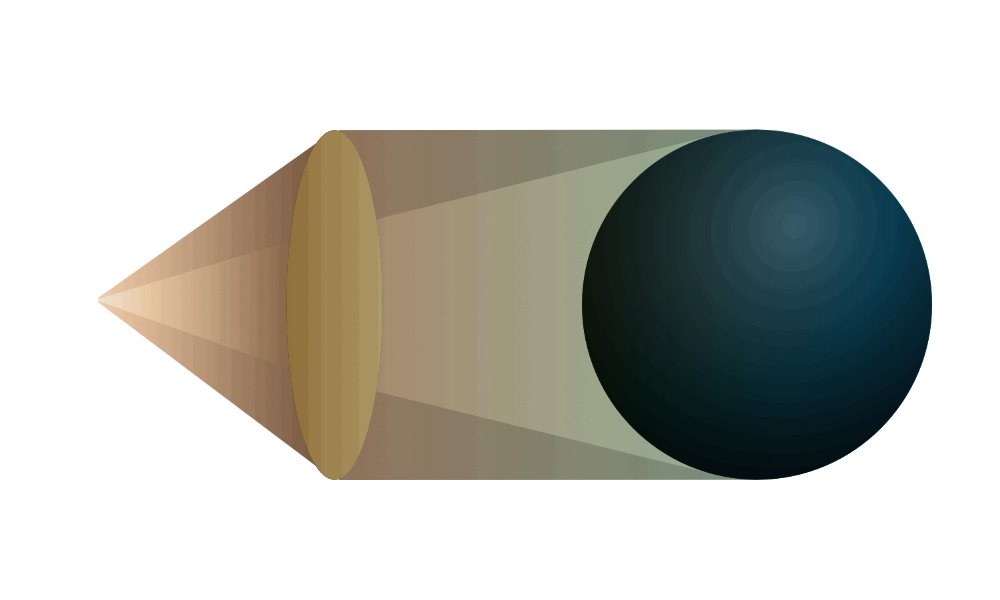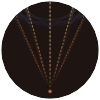The I Is Not Here
Fred Astaire and the Feedback Membrane of Apperceptive Consciousness

Consciousness is a localized resonance, achieved via projection of a subset of a richly-connected high-dimensional structure onto a low dimensional space, which when applied as feedback to the generative unconscious computational network, selectively amplifies its own preimage. Consciousness is a ghost which summons the living.
A conscious topology is a relatively flat and sparse surjective transform, which hides overdetermination and redundancy. Consciousness is not strictly speaking a subspace of unconsciousness, but rather a low dimensional projection which selectively generates resonant activation depending on orientation. This orientation could be characterized as a tangential space.
The purpose of this projection-feedback function is the exploitation of nonlinearity in achieving efficiency gains as aftereffect: apperceptive consciousness itself is an obstacle to performance, but the coherence left behind testifies to its role as calibration. An animal does not generally become aware of itself except when something goes wrong. A nervous system is potentially very expensive, and must be constantly optimized such that minimal metabolic expenditure achieves maximum result. By applying a kind of "lowpass filter", or radically reductionistic projection of neural activation as feedback, the most salient features can be amplified, retained, and potentially debugged. Most incoming data and the vast majority of the combinatorial possibilities of behavior are discarded: I argue that what we experience as consciousness is partly epiphenomena of this search-and-prune routine, and partly the adaptive exploitation of selective feedback located right at the heart of the issues of intelligence, learning, health, and purposive behavior.
Quite a mouthful - and yet despite the danger we're in, whenever we bow low before this golden calf called "consciousness", my goal here is to find another vector of attack: the prejudices surrounding this concept will not melt away just by being ignored, nor can they be "transcended" away - intellect must serve its best purpose and provide the scalpel we need to dissect this unholy thing, this marriage of profundity and sterility, pregnancy and denial. In other words, like our best teachers within the lineage of Western critical theory - Nietzsche, Spinoza, Socrates and Heraclitus come to mind first - we want those same intellectual gymnastics which almost unfailingly lead the human race astray to become the "bent-back bow" which might fire an arrow into the heart of human experience, destroying as much as it creates, setting aflame as much as it fertilizes.
The distilled hypothesis runs like this:
Apperceptive consciousness is a surjective transformation function operating on sensory input, whose purpose is to establish selective resonance with its own preimage, such that the coherence of the unconscious structure is improved. The prime case is always proprioception: it is the bodily macrostructure and its need for precise navigation, which necessitates constant calibration. Thus is apperception born.
Looking carefully at the physiology of the cerebellum, I argue that we should conceive of proprioception as a finite-dimensional reprojection of a topologically rendered abstraction of afferent input: the informative density of nerve endings in space and spike trains in time is radically reduced, translated, and reconstructed within the computational matrix that is the cerebellum.
However, proprioception is generally focused on the thin edge: between the body envelope and potential contact. The arms of the amoeba stretch forth, the cell wall shivers. Apperception therefore is a kind of interoception - largely imagined, but built from the ingredients of muscle extension detectors, gastrointestinal signals, and anything on the interior actually enervated, however slightly. Our "inner life" is largely a useful illusion.
The question is whether proprioception as metaphor, or actually as bottomup structural process, can be shown to be constituent of conscious activation. Consciousness is largely a matter of redundancy: a consequence of blockage, of signal bottleneck, and therefore an emergent character of many proprioceptive subroutines and their coalescence upon a local domain.
In other words, do we only become aware of ourselves in the "mirror stage", as mirage, as uncanny Doppelgänger, as imposter - or is the bodymind truly something organic, healthy, vital, the real "soul" we've been looking for? My answer is clear enough: the idea that the "self" does not belong here, that it must have some "higher" origin by definition, is only the culminating delusion of a deeply alienated and suspect human creature - it's very common in the last stages of a psychotic breakdown, when it starts to go sour, to conclude that the previous shattering realization "the I is not" should be translated as "I am not here", which quickly becomes "The body is unreal". And that's the history of postaxial philosophy in one sentence. In fact, the circle is coming back around: isn't there a uniquely suspect affinity between the feverish religions of Late Antiquity and their obsession with "higher worlds" and "other origins", and the increasingly common conviction among the commonest people of the 21st century that "the universe is a computer simulation"? Anyone else detect the sticky sweet smell of sedentary bodies and emotional stunting?
The apperceptive self must be awoken: the proprioceptive system must be taxed, trained, made to dance. I recently found a movie featuring Fred Astaire at his most brilliant: I hadn't realized how much like Bruce Lee his body was - taut, a Swiss caliper of time...
Watch Fred warm up in that clip: the first thing he does, is diminish his consciousness and push his apperception down, into his belly, to internalize the rhythm in his abdominals. The marks of self-consciousness fade from his face. The I is not here.
Consciousness frames, while unconscious process does its job: we do almost nothing consciously, yet it is present while we do things. What's it for? For narration, for gross course correction, for the backpropagating activation of purposive behavior. The locality of consciousness is a boundary ring of inhibition surrounding a zone of selective excitation: thus it frames what we do, but does not do much of anything, despite our much-cultivated delusions on this point.
Consciousness is a feedback membrane: a containment field, an inner surface, a local refraction index.
Consciousness as localized feedback: which pushes the local system into higher-order dissipation channels, which disrupts local maxima and reified paths, which potentiates the discovery of global maxima. It's fruitful to compare its effect to an annealing technique: consciousness disrupts and excites, effectuating a stochastic search for other dissipation modes.
Consciousness thus has no content of its own, nor any discrete location. It is itself probably an emergent property of every system it "visits".
Consciousness as a moving lens, capable of changing shape, diameter, focal length, and location:
- A wide lens and coherent focus: the broad mind.
- A narrow lens but coherent focus: the concentrated mind.
- A wide lens but fuzzy focus: the scattered mind.
- A narrow lens and fuzzy focus: the anxious mind.
I've found, both in theory and through years of meditative practice, that the best way to handle the almost radioactive concept of "consciousness" - surrounded by all its flatterers and would-be courtiers - is to treat it as simultaneously trivial, dangerous, and vital. It is localized feedback: therefore nothing much on its own. It is generated by anxiety, and thus its cultivation as an end-in-itself is a sign of degeneracy. It is a reparative and calibrating subroutine, and thus its power is almost unlimited.
Consciousness as diagnostic routine: "What's wrong here?"
Consciousness as selective suppression: "Not now."
Consciousness as confabulatory communication: "What's the story?"
Consciousness is a diagnostic routine. An animal only becomes aware of itself when something goes wrong: in the cracks between successful instinct, lies the potential for self-awareness. It's a mode of recontextualization, in order to assess danger, futility, failure - embarrassment and consciousness are close cousins.
In biological terms, every diagnostic possesses the power of repression. There is a close relationship here to what the ethologists call "sickness behavior": prioritization of healing means the repression of many other functions, and thus is "anxiety" born. Again it's vital not to be caught in the trap of insisting that to "be conscious" is an end-in-itself. Consciousness is a mode of deferral: to disrupt and defer other processes, in order to evaluate the scene and adjust trajectory.
Consciousness is the power of disruption, canceling, hesitation, unbinding. The power of valuation shifts: revaluation. Thus its connection with linguistic capacity: symbolic manipulation needs semantic displacement, which first happens when instinctual frustration seeks novel paths. Failure engenders frustration, which engenders inventive gratification paths - but it's the element of social witness which engenders embarrassment - this is generally why we only see the most social animals as "self-aware".
Becoming aware of something halts it - disrupts, interrupts, overloads. It is a testing and debugging mode: thus its connection with the narrative I, dreaming, strategizing, scheming.
Recontextualization: seeing oneself from the outside. The purpose is to assess danger, status, purpose. "What am I doing here?" In the phrase "Who am I?", the key term is not "I", but who: this token is an appeal to the context and the group. It asks: "What am I in this place, in this role, with these goals?"
And again, thus the paradoxical connection between healing and consciousness: recontextualization is the first step of psychotherapy. You must unlearn and undo connections via the power of telling the story again, in a new context, with a novel audience.
Around 1910, Freud made a critical mistake: despite his better intuitions in Studien über Hysterie and Der Traumdeutung, he began to assume in his theoretical work that repression "emanated" from the conscious systems, as the first wall of censure against unwanted impressions. But this is false: conscious activity is not nearly powerful enough for something so herculean as systemic repression. When people pretend to forget, when they refuse to know what they know, when they repress beyond recall, conscious activity is at most the distracting magician's hands, the fluttering of a kerchief, the eyelashes of the pretty assistant: consciousness defers, halts, and induces mild hypnosis, but real repression is only sustained through symbolic exclusion, which takes place at deep levels of the unconscious semantic topology.
In fact the situation is almost the reverse: consciousness has the paradoxical power to lift repression. Consciousness is a feedback membrane, characterized by a noise complement inducing stochastic resonance, which makes possible the traversal of repressed paths. This is what's known as "free association". Talk therapy is about crossing through repressed semantic zones, in order to disrupt repressed content. But the actual healing work takes place unconsciously.
In order to plant the feet of those good-faith readers, those few who stick it out and have learned to trust my poet's errancy to yield to my analytic rigor, I offer this outline of the theory I'm pitching - as though I were pitching woo on a moonlit night with my bamboo mouth harp outside the hut of my Laotian sweetheart, speaking a secret lover's tongue:
Stochastic resonance in the proprioceptive system, and the likelihood of its involvement in apperception. The relationship between consciousness and white noise, pink noise, stochastic filtering and signal approximation.
The topology of neural information, or "inner space". Whether neuromorphic experience can be characterized as continuous manifolds, or as discrete graphs, or both. Should we be using the metaphors of signal analysis or graph theory?
The geometry of neuroelectrodynamics, or "physiological space". Which can be reframed as: whether and to what degree the ancients were correct in suspecting that exhaustive geometrical configurations constitute the possible stations of the "spirit world".
The power of meditation to refine all these processes of consciousness. The degree to which we can reasonably demonstrate an upward percolation of basal neural function into more easily measured intelligence.
Be aware that I'm mixing acoustical analysis in the form of stochastic resonance and thus nonlinear dynamics, with topology and thus graph and set theory. It's a heady brew, which I admit might occasionally sound more fashionable than I'd like - I only happen to think it's correct in this case. I almost cringe when I realize how relevant it is to some of the more adventurous threads in AI research: I too am only a product of my time after all... Maybe it's having spent too much time conceiving of invisible logical paths when writing code, that makes my generation incline so uniformly to graph theory and functional analysis... Space exists but the distance function is mutable. Shifting bits in virtual space will habituate you to think of all experience as "virtual space".
The question is: how can a complex electromagnetic signal be analyzed like a graph, and can a graphical structure yield to harmonic analysis? Even conceived as a narrow signal channel, the number of dimensions involved in a spike train seem sufficiently high to produce topological features of interest: there's the frequency domain, amplitude, the spectral distribution itself, its changing shape over time, its interaction with global parameters or states of excitation, and the variation between signals transmitted over multiple incoming channels. I want to study neuronal activity as music, and oddly it seems the best means of doing so is to reduce it to geometrical and topological relations: relations of ratio, continuity, and path-connectedness. But perhaps that's because music is precisely the intrusion of geometrical constants into the mediation of time: certainly that's what Plato and Nicomachus wanted us to believe. Then is it possible that neural activity is the real "music of the spheres"?
My goal is to employ mathematical language to develop an at least minimally plausible theory of the function and evolutionary value of consciousness, in such a way that also accounts for meditative experience and inspires the practitioner.
Our theory of many-to-one in answer to the question, "what is consciousness?", can now be reformulated:
Apperceptive consciousness: stochastic amplification and feedback, which may be a response to signal loss or incoherence. The additive noise so characteristic of "paying attention", both clarifies and suppresses: a ring of inhibition containing a region of reflexive overstimulation.
Narrative consciousness: simplification, emergent symbolization, auditory hallucination exploited for producing simulated instinctual coherence for longterm gratification-delayed behaviors. An artifact of human hyperadaptivity: the ability to "think" is largely about the ability to remember and rehearse complicated noninstinctual behaviors. Narration is mnemonic, and thus "thought" originated in song: and so Aboriginal "songlines" take on new meaning...


